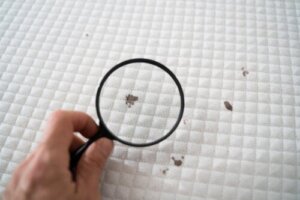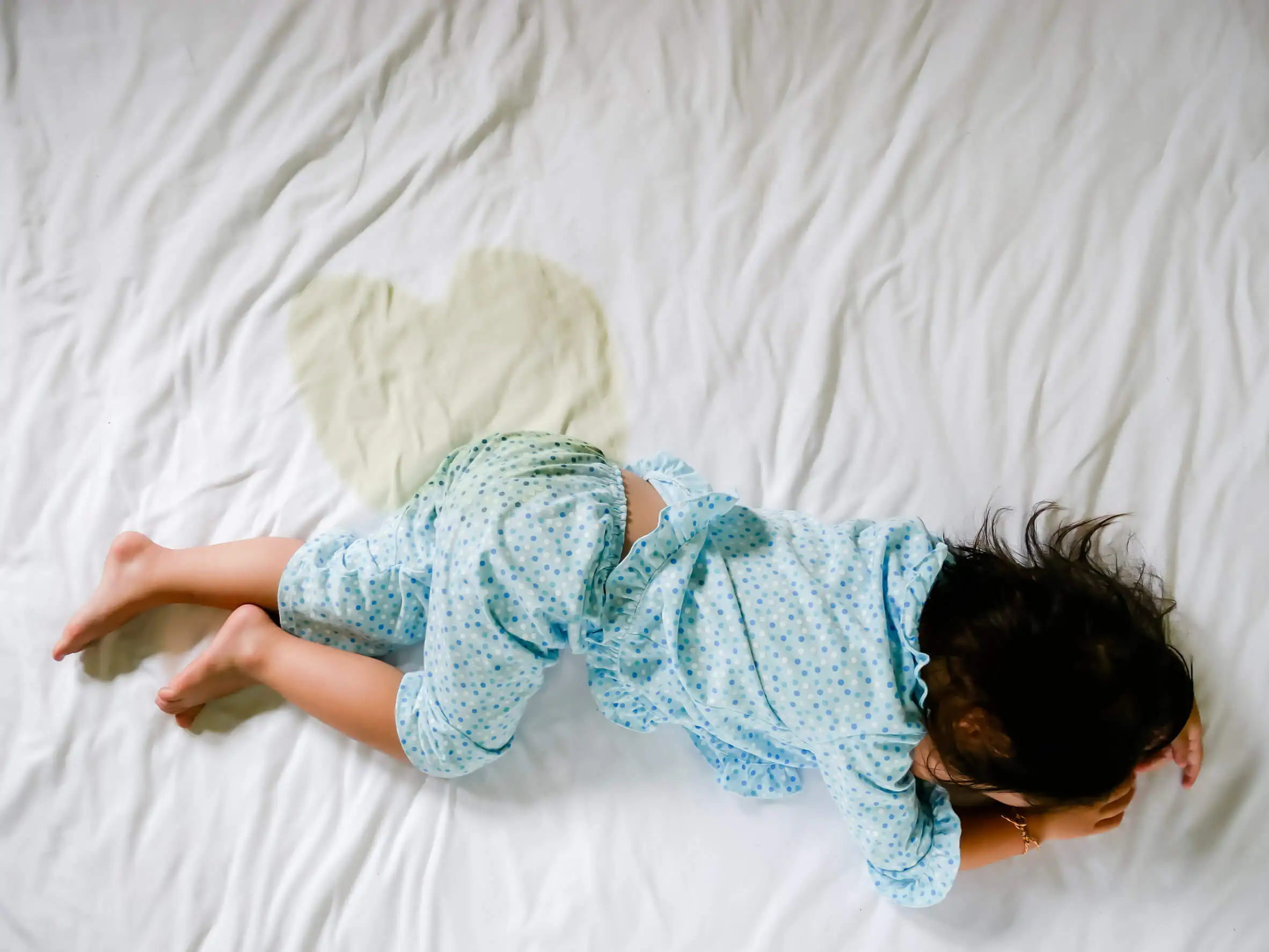How to Clean a Moldy Mattress

The bed is one of the elements of the home that’s most exposed to different types of stains. Some are derived from human contact, others from humidity, and others from use. At the same time, it’s an object that must be kept clean, since it’s constantly related to the skin. Cleaning a moldy mattress is possible.
This type of stain can appear due to a high and sustained level of humidity in the environment. However, it can also appear due to sweating, contact with blood, and other human secretions. Cleaning a moldy mattress is very important for health, because it’s the place where you sleep and spend several hours.
What is mold and why does it appear on a mattress?
A mattress has the disadvantage that, thanks to its size, it can’t be put in a washing machine. Hygiene methods must therefore be based on prevention. However, if the accumulation of moisture has caused the appearance of mold or other stains, there are different techniques for cleaning a mattress.
White vinegar, baking soda, and soap are some effective elements for that purpose. However, each of them should be applied in a different way.
Mold is a fungus that is found in dark and damp spaces, but also outdoors. There are many types of molds; some with characteristics that are more harmful to humans than others. For example, allergenic and pathogenic molds are easier to eliminate with household products. Meanwhile, the toxic ones represent a greater threat and must be treated by a specialist.
4 methods to clean a moldy mattress
If the presence of mold can’t be avoided, due to carelessness or excessive humidity, it’s possible to clean and disinfect the mattress with the following techniques.
1. Soap and water
Once these stains are detected, the simplest solution to remove them is to pass natural soap and water. These components prevent the fabrics from deteriorating and are usually effective with basic dirt, such as those derived from food or cosmetics.
However, for more complex stains, it’s advisable to apply other methods. In addition, in the case of wetting the mattress with water, it’s important to take into account that moisture doesn’t accumulate, as this can actually cause the reverse effect.

2. Clean a moldy mattress with white vinegar
One of the main advantages of applying vinegar is that, in addition to combating mold stains, it reduces the odor they give off. This is another problem derived from humidity and is difficult to eliminate. On the other hand, baking soda helps to neutralize the fragrance while disinfecting the surface.
3. Treat humidity
Having a mattress permanently exposed to a humid environment favors the appearance of mold, dust mites, and microorganisms. When these get in contact with the human body it has serious health risks, especially in the respiratory area.
Ventilating the mattress and taking it out in the sun for a while is an effective option to prevent the accumulation of humidity. Before replacing it, it’s important to also vacuum it to remove pollen and mold.
4. Isopropyl alcohol
One of the most common and effective methods of cleaning a moldy mattress is to soak a cloth in a solution of water and isopropyl alcohol. The approximate measure is 50% of each component and the cloth should be clean.
Rub it over the affected area of the mattress in a circular motion. When finished, wipe again, but only moistened with water.
Some other considerations
In the case of identifying the presence of this fungus in the mattress, it’s important to take the necessary measures for its immediate elimination. In general, 48 hours after wetting, it’s still possible to clean and disinfect it effectively.
If the bed linen was in contact with the fungus, it should be removed and placed in the washing machine. It’s necessary to apply a washing format with hot water and add some bleach or pine oil-based disinfectant.
We think you may be interested in reading this, too: Eco Friendly Methods to Clean and Disinfect the Fridge
How to prevent a moldy mattress
One of the best ways to combat mold stains on the mattress is to prevent them. To do this, you have to take into account different aspects. The most important is the accumulation of dust, which is typical for bedrooms.
Dusting the mattress is possible with a vacuum cleaner, as it can absorb most of the particles from the surface. If vacuuming and ventilation methods are to be applied, they should be carried out with the necessary protection. That is, you’re going to need gloves for your hands, goggles for your eyes, and a face mask.
On the other hand, reducing the humidity in the environment helps to prevent mold stains. Items such as dehumidifiers are effective in removing up to 1 liter of water present in the air per day. In addition, placing mattress protectors when not in use provides an extra layer of protection against external agents.
Other everyday techniques suggest turning the mattress over from time to time, because the underside is out of contact and pressed against the base. This leads to mildew and damp stains over time, as well as odors.

Products to avoid when cleaning a moldy mattress
Some commercial products are harmful to mattress fabrics. It’s important not to use the following components on the mattress surface:
- Bleach: This can severely damage the mattress, fade it, and cause irreversible stains.
- Excessive water: The use of water should be delicate. Apply immediate drying methods; otherwise, it favors the generation of humidity and the appearance of mold and fungus.
- Oxygenated water: It’s possible that it may affect the fabrics and generate stains.
Like this article? You may also like to read: How to Clean the Beauty Blender or Blurring Sponge Without Damaging It
Encourage hygiene
Hygiene methods have to be accompanied by a change of sheets and all bedding at a maximum frequency of every two weeks. Although this may seem unimportant, shaking out the newly raised space, including comforters and pillows, is important to avoid the accumulation of dirt.
Another necessary strategy is to check the support or platform where the mattress is supported. Occasionally, wooden bases can be affected by mold and it can be transported to the fabrics from there. If an unused mattress is going to be stored, make sure it’s in a place with low humidity.
All cited sources were thoroughly reviewed by our team to ensure their quality, reliability, currency, and validity. The bibliography of this article was considered reliable and of academic or scientific accuracy.
- Encalada Paredes, María Estela, Detección de hongos en la cama avícola, causantes de micosis en los pollos de ceba. REDVET. Revista Electrónica de Veterinaria [Internet]. 2011;12(6):1-21. Recuperado de: https://www.redalyc.org/articulo.oa?id=63622160003
- Arias, Luis Alejandro, Tautiva, Luz Andrea, Piedrahíta, Wilson, Chaves, Bernardo, Evaluación de tres métodos de control del Moho blanco (Sclerotinia sclerotiorum (Lib.) de Bary) en lechuga (Lactuca sativa L.). Agronomía Colombiana [Internet]. 2007;25(1):131-141. Recuperado de: https://www.redalyc.org/articulo.oa?id=180316240015
- Robledo, Gerardo, Urcelay, Carlos, Heredia, Federico, Morera, Guillermo, Cagnolo, Luciano, Interacciones entre hongos de la madera (Agaricomycete) y árboles nativos y exóticos de un ecosistema urbano (Córdoba, Argentina). Bosque [Internet]. 2014;35(3):391-398. Recuperado de: https://www.redalyc.org/articulo.oa?id=173133052013
- Marmolejo, José G., Méndez Cortes, Heriberto, Diversidad de hongos causantes de pudrición de la madera en cinco especies de pinos en Nuevo León, México. Revista Mexicana de Micología [Internet]. 2007; (25):51-57. Recuperado de: https://www.redalyc.org/articulo.oa?id=88302510
This text is provided for informational purposes only and does not replace consultation with a professional. If in doubt, consult your specialist.








